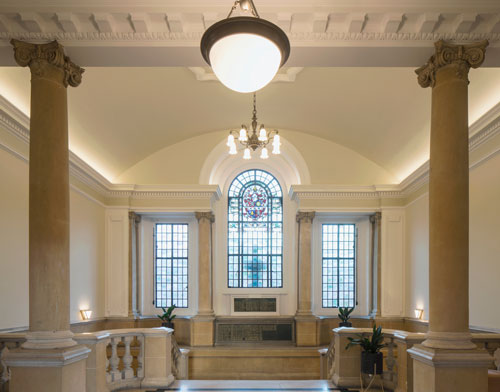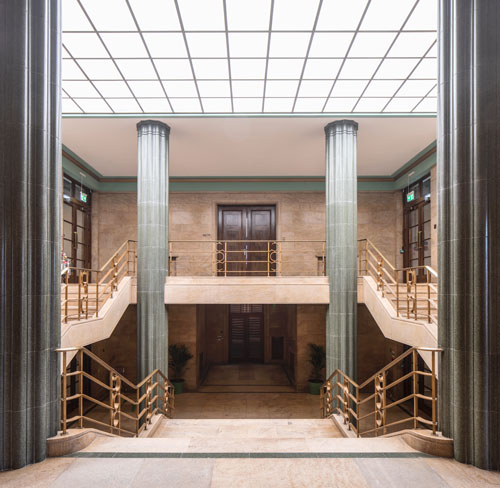Heritage lights are reused at town hall refurb

Heritage luminaires have been reconditioned and reused in a major refurbishment of Bromley town hall in Kent.
The period fixtures, some installed in 1907 and others in 1939, have been upgraded to LED by heritage specialists Madson Black in a scheme by independent lighting design practice Nulty.
Nulty’s design supports the wider goals set by the architecture practice
Cartwright Pickard and the interior design studio Fusion Interiors Group, to reclaim the heritage of the Grade II-listed architecture and breathe new life into the flexible co-working space and all-day dining restaurant that now occupy the building.
In the 1907 section, the original aesthetic was largely intact and therefore the lighting is primarily decorative and designed to complement the building’s original period features.
Nulty’s brief was to restore the original design aspirations of the old town hall and to reinvigorate the building to accommodate the demands that come with a mixed-use scheme.
In terms of the lighting design, says the firm, this meant honouring the historical context by reinstating original light fittings found on site, and then trying to unify the heritage story with the contemporary lighting elements that had to be implemented in the co-working space and restaurant.
The team studied various source materials to understand the style of luminaires that were originally used and updated lighting elements to make them appropriate for a contemporary context, which included concealed the emergency lighting elements within the heritage pieces.
It was a case of balancing repurposing goals with the structural constraints and technical requirements of the mixed-use scheme.
The juxtaposition of old and new plays out in the reception area, where suspended glass pendants have been used to create a focal point above the desk and seating area.
The composition forms a welcoming path of light, which pulls guests through to the more architecturally significant areas of the scheme where the traditional lighting language begins.
Across the main circulation areas, original decorative fittings were reinstated or replicated to complement period features such as vaulted domed ceilings, cornices, and archways. In the building’s iconic central hall, artificial skylights were used to flood the space with light and pay reverence to the 1930s skylights that were removed when the floor above was extended. The backlit ceilings are inherently modern and provide dynamic white light that accurately reflects the colour temperature and intensity of external light levels.
A new restaurant takes up residence in the old Courthouse, a historic part of the building that has been opened to the public for the first time. Here, integrated perimeter lighting accentuates the wood panelled walls and uplights illuminate artwork and help to elevate the space. Decorative glass pendants were reintroduced to ensure that the original design intent has been honoured and supplemented at a lower level by globe pendants to evoke a sense of intimacy.
In the shared Club Lounge, housed in the former Council Chambers, the lighting is unapologetically restrained to allow the large stained-glass windows, domed soffits, and columns to sing. Bowl pendants were reinstated at a high level and teamed with discreet uplights that highlight the rhythm of the architecture.
• Diary date: Circular Lighting Live 2024, Recolight’s flagship conference and exhibition, which takes place on Wednesday 9 October 2024 at the Royal College of Physicians in London. Free to specifiers, Circular Lighting Live 2024 will feature leading experts, specifiers and policy makers who will share their insights into forthcoming standards and legislation, emerging technologies and new business models. More info: www.circularlighting.live


